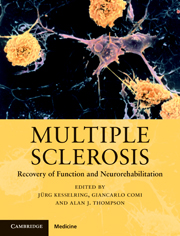15 results
Section 4 - Rehabilitation: sectorial interventions
-
- Book:
- Multiple Sclerosis
- Published online:
- 05 August 2011
- Print publication:
- 07 October 2010, pp 165-239
-
- Chapter
- Export citation
Preface
-
-
- Book:
- Multiple Sclerosis
- Published online:
- 05 August 2011
- Print publication:
- 07 October 2010, pp xi-xii
-
- Chapter
- Export citation
Contributors
-
-
- Book:
- Multiple Sclerosis
- Published online:
- 05 August 2011
- Print publication:
- 07 October 2010, pp vii-x
-
- Chapter
- Export citation
Multiple Sclerosis - Half title page
-
- Book:
- Multiple Sclerosis
- Published online:
- 05 August 2011
- Print publication:
- 07 October 2010, pp i-ii
-
- Chapter
- Export citation
Section 2 - Assessment of mechanisms and disease status
-
- Book:
- Multiple Sclerosis
- Published online:
- 05 August 2011
- Print publication:
- 07 October 2010, pp 79-126
-
- Chapter
- Export citation
Chapter 13 - Electrophysiological assessment in multiple sclerosis
- from Section 2 - Assessment of mechanisms and disease status
-
-
- Book:
- Multiple Sclerosis
- Published online:
- 05 August 2011
- Print publication:
- 07 October 2010, pp 112-119
-
- Chapter
- Export citation
Contents
-
- Book:
- Multiple Sclerosis
- Published online:
- 05 August 2011
- Print publication:
- 07 October 2010, pp v-vi
-
- Chapter
- Export citation
Multiple Sclerosis - Title page
-
-
- Book:
- Multiple Sclerosis
- Published online:
- 05 August 2011
- Print publication:
- 07 October 2010, pp iii-iii
-
- Chapter
- Export citation
Section 1 - Basic mechanisms
-
- Book:
- Multiple Sclerosis
- Published online:
- 05 August 2011
- Print publication:
- 07 October 2010, pp 1-78
-
- Chapter
- Export citation
Index
-
- Book:
- Multiple Sclerosis
- Published online:
- 05 August 2011
- Print publication:
- 07 October 2010, pp 240-247
-
- Chapter
- Export citation
Copyright page
-
- Book:
- Multiple Sclerosis
- Published online:
- 05 August 2011
- Print publication:
- 07 October 2010, pp iv-iv
-
- Chapter
- Export citation
Section 3 - Rehabilitation: general aspects
-
- Book:
- Multiple Sclerosis
- Published online:
- 05 August 2011
- Print publication:
- 07 October 2010, pp 127-164
-
- Chapter
- Export citation
Chapter 2 - The physiopathology of multiple sclerosis
- from Section 1 - Basic mechanisms
-
-
- Book:
- Multiple Sclerosis
- Published online:
- 05 August 2011
- Print publication:
- 07 October 2010, pp 8-21
-
- Chapter
- Export citation

Multiple Sclerosis
- Recovery of Function and Neurorehabilitation
-
- Published online:
- 05 August 2011
- Print publication:
- 07 October 2010
Foreword
-
-
- Book:
- The Clinical Neuropsychiatry of Multiple Sclerosis
- Published online:
- 13 August 2009
- Print publication:
- 17 May 2007, pp vii-viii
-
- Chapter
- Export citation



